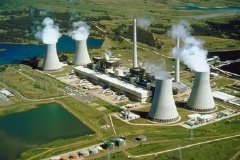Apr 22 2009
On the eve of Earth Day observances, a new report calls for an energy revolution in the operation of electric utilities if greenhouse gas emissions are to be significantly reduced.

The report raises the question of how much electric utilities will need to pay for their ongoing carbon emissions and analyzes current levels of risk disclosure to investors.
Sponsored by the California State Teachers' Retirement System (CalSTRS) and conducted by the Carbon Disclosure Project (CDP), the Electric Utilities Report 2009 examines how electric utilities around the globe currently measure and manage carbon dioxide emissions. To view the report, go to www.cdproject.net.
Key Findings
- The electric utilities industry has an understanding of climate change but also has a long way to go to transform operations to a low-carbon economy
- Only a small number (16%) of utilities are setting and disclosing absolute targets for reducing greenhouse gas emissions
- Less than half disclosed capacity and energy production figures by fuel type (e.g. coal, gas) which is a critical factor for investors in making decisions
- The response rate to the survey has improved, from 44 to 53 percent, since the first electric utilities report in 2006, with a marked increase in the US response rate from 48 to 67 percent
The electric utilities industry accounts for 25 percent of carbon dioxide emissions worldwide; the largest share among all industries. The report cites that unless reduced, the buildup of greenhouse gases from utilities' burning of coal and fossil fuels will accelerate global warming and catastrophically alter the planet's environment. This report compares the level of disclosure and quality of planning among individual utilities for reducing carbon dioxide emissions, as measuring emissions is essential to being able to manage them.
Paul Dickinson, CEO of CDP commented: "This sector is the most carbon intensive within the global economy and the report shows that although many firms understand climate change is a business issue, we still have a very long way to go to de-carbonize the sector to ensure emissions are cut in line with scientific recommendations."
Founded in 2000, the CDP works on behalf of 475 institutional investors such as CalSTRS to track how the world's largest companies are measuring and reporting their greenhouse gas emissions. This report analyzes responses from 110 of 249 of the world's largest publicly held electric utilities.
"CalSTRS chose to sponsor the Electric Utilities Report 2009 because carbon disclosure and climate change reporting are of key importance to investors. Our members depend on us for their retirement security and we have a financial stake in building the long-term value of the most carbon-intensive sector of our economy. Electric utilities must act now to reduce their exposure to greenhouse gas emissions in the coming carbon-regulated economy," said CalSTRS Chief Executive Officer Jack Ehnes.
Utilities' Quality of Planning for Future Emissions
The report's findings illustrate how electric utilities are planning for the future, both in terms of anticipated greenhouse gas emissions and how they plan to reduce those emissions.
- While 61 percent of utilities forecast future greenhouse gas emissions, 59 percent say they have in place emission reduction plans, but not all have publicly disclosed targets for reduced emissions.
- Only a small number of utilities are setting and disclosing absolute emission reduction targets, while a higher percentage are setting intensity targets that still allow greenhouse gas emissions to grow.
- Less than half of the surveyed companies disclosed current electricity generation capacity and production figures by fuel type, and only 14 out of the 110 respondents provided data on forecasted capacity and production.
This lack of disclosure raises the question of how much electric utilities will need to pay for their ongoing carbon emissions - or pass on to consumers - as emissions trading systems and carbon taxes come into play. More transparency would help investors to determine how well a utility is positioning itself for future competition.
Impact on Consumers
In addition to environmental impact, the report's findings can also be used to forecast how utility rate payers could be affected. Governments are increasingly turning to concepts such as cap and trade and tighter regulations on carbon emissions from electric utilities. Utilities that don't manage risk by exploring alternative energy sources or investing in technology to reduce emissions could be forced to pass higher expenses onto consumers. In addition, utilities who aren't prepared to measure, much less reduce emissions, expose themselves to possible fines and higher costs from having to purchase carbon offsets when regulation increases.
Carbon Disclosure Leadership Index
The report also employs a Carbon Disclosure Leadership Index (CDLI). This ranks all 110 electric utilities responding to the survey on the extent and quality of their climate change disclosure. On a scale of 1 to 100, the average CDLI score for North American utilities was 49.
- Of the two California utilities in the survey, Edison International scored 47 and PG&E scored 51.
- U.S. utilities included: Duke Energy Corporation at 61, Consolidated Edison, Inc. at 75 and Exelon Corporation at 78.
- The three highest scoring companies globally were Australia's AGL at 81 and Iberdrola and Endesa from Spain at 82 and 85 points, respectively.
Energy Revolution Needed
The report cites the need for an "energy revolution." Acting now to plan for the future is essential as existing power plants relying on coal and other carbon emitting fuels will lock in a flow of greenhouse gases for many decades. This underlines the importance of policies that put a price on carbon, slow electricity demand growth and encourage faster replacement of high-emitting plants with lower-emitting and renewable energy alternatives.